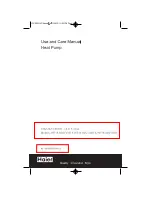
VTS reserves the right to implement changes without prior notice
VENTUS S-Type Air Handling Units
The measurement should be carried out at the duct's fragment with parallel walls and straight segments at
least 6 times longer than the duct diameter or equivalent diameters before the test point and not less than 3
diameters after it. In the real ventilation system finding such a long straight fragment can be a problem. In such
a case determine the measurement cross-section in a place where the smallest distortions of the air-flow are
expected and intensify a network of test points. The location of the measurement cross-section should be
determined on the system design stage. Detailed recommendations concerning the air-flow measurement and
the location of the test points are defined by the ISO 5221 standard.
We estimate the output is considered to be sufficient unless it differs more than ±10% from the
recommended one. In case of bigger disproportions, the output matching the recommended one can be
achieved by:
- an adjustment of the ventilation ducts network,
- changing the adjustment of the main damper,
- changing the fan rotary speed.
While increasing the fan's rotary speed you must by all means control the motor's power consumption and not
allow to exceed the recommended rated current value. For durability and permissible operation parameters it is
also very important not to exceed the maximal rotor speed. In justified situations, when there is a need to
increase the air-flow output, it is recommended to use a more powerful fan's motor.
In systems equipped with dampers which automatically change the ratio of fresh, recycled and exhausted air or
the by-pass flow ratio, output measurements and the main damper adjustment should be carried out in the end
setting position. Next check the air ratio and the overall output in the other end position and, if necessary, carry
out appropriate adjustments in order to the achieve proper ration at constant overall output.
6.1. Cooler performance adjustment
Adjustment of the cooler performance should be carried out in conditions similar to the rated ones.
The temperature of the cooling agent is controlled in this way as well. If the cooler operation effect is not
satisfactory, an appropriate adjustment is required. It can be carried out using the following methods:
- an adjustment of the cooling medium amount (water coolers),
- an adjustment of the air amount passing through the AHU (water cooler),
Coolers operate in most cases in complex air-conditioning systems equipped with an automatic control.
Automatic control devices should be tested not only in extreme conditions but also in intermediate cooler load
circumstances.
7. OPERATION AND MAINTENANCE
Personnel in charge of AHU operation should read through this documentation before starting
any operation and maintenance activities. When no such personnel with appropriate skills and
competence is available, periodic inspections should be carried out by the authorized VTS
service providers.
EN
Any damages of the AHU or its parts resulting from not following the guidelines stated in this
documentation will not be subject to warranty claims.
Basic AHU technical data such as type, parameters and dimensions of the most significant parts are provided in
the Technical Data Card supplied with each device.
Any AHU maintenance operations should be carried out with the device turned off.
In order to ensure safe device operation, a service switch cutting off power supply to the motor
during service operation must be installed outside the fan section. Switching off the power circuit
with the service switch must be done in the non-voltage state. The service switch should be
located close to the inspection panels of the fan section.
Thorough and regular maintenance, as well as technical inspections of the AHU and its components, are
necessary in order to detect the failures at an early stage - before more serious damages appear.
This documentation includes only general guidelines regarding control periods, which ensure error-free operation
of the AHU due to various possible external conditions. Control periods must be adjusted to the local conditions
(contamination, number of start-up cycles, load, etc.).
18





























